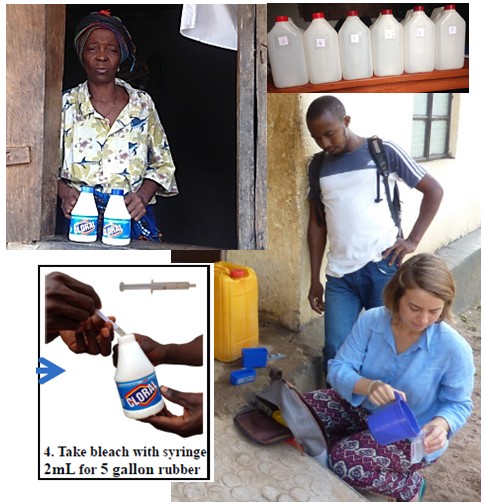 A specific study was done for 6 months in 2016 with a student – Aurélie Moy – to have a better understanding of the behave of the villagers toward household chlorination:
A specific study was done for 6 months in 2016 with a student – Aurélie Moy – to have a better understanding of the behave of the villagers toward household chlorination:
- assessing if the uptake of the beneficiaries was really effective (for this, Aurélie visited all the targeted villages and did some random surveys among several household, but she also visited all household of a sample of villages);
- visiting the shops to assess if the supply was really effective
- evaluating what was the real consumption of chlorine
- testing if the residual of chlorine was good enough to ensure disinfection
- and observing and quantifying the impact on decrease on diarrheas cases.
The results are quite satisfying, because in brief…
- 100% of communities continue HHWT, (survey of 64 communities out of 107 in whole Bombali district)
- 80% of pots have treated water at all times (survey of 340 pots in 29 communities)
- Introduction of HHWT has a strong positive impact on health in the communities: Prevalence of diarrhea of Children under 5 years drops from 12% to nearly 0% (although these are only global tendencies).
- Remanence of chlorine and its strength is mostly influenced by the initial quality of water, cleanness of the containers rather than an eventual gap in conditions of storage or the quality of bleach that can be found in the local shops. It also shows that rain water has to be treated as it can be contaminated during collection.
The full study’s report is available on Pratiques website: www.interaide.org/pratiques/content/study-household-water-chlorination-sierra-leone-december-2016?language=en
Aurélie also  did a short exhibition to testimony on her mission…see related post www.interaide.org/watsan/sl/aurelie-put-a-nice-focus-on-hhwt-in-salone/
did a short exhibition to testimony on her mission…see related post www.interaide.org/watsan/sl/aurelie-put-a-nice-focus-on-hhwt-in-salone/



